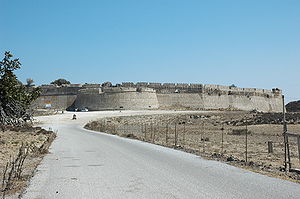Andimachia fortress
| Andimachia Fortress (Κάστρο Αντιμάχειας) | ||
|---|---|---|
|
Andimachia Castle, view from the west |
||
| Creation time : | 14th Century | |
| Conservation status: | ruin | |
| Geographical location | 36 ° 48 '9.7 " N , 27 ° 7' 40.2" E | |
|
|
||
The fortress Andimachia ( Greek Κάστρο Αντιμάχειας ) is a medieval fortress of St. John 3 km east of Andimachia , the administrative seat of the municipality of Iraklidis on the Greek island of Kos .
location
The strategic position on a plateau at a height of about 170 m above the bay of Kardamena allowed the control of the sea route between Kos and the island of Nisyros to the south as well as the north-south connection in the interior of the island.
history
A castle already existed in the same place in Byzantine times. The first written reference points to the Grand Master of the Order of St. John Helion de Villeneuve as the builder between 1337 and 1346. A religious assembly decided in 1383 to set up a prison for convicted knights. Several Ottoman attacks in the 15th and 16th centuries could be repelled due to the construction. So also the 23-day siege of the island in June 1457. After the fortress Neratzia in the city of Kos and the Peripato castle and the surrounding area had been abandoned, the island's population (12,000 people) withdrew to the fortresses Palio Pyli , Kefalos and Andimachia . Since the other fortresses were difficult to access, the besiegers concentrated on the fortress Andimachia, which was only defended by 15 knights of the order with about 300 islanders. 15 defenders died, the besiegers lost 1,000 dead and over 2,000 wounded. Almost half of the island was controlled by the besiegers, but for inexplicable reasons they withdrew after extensive destruction and looting. After damage from an earthquake in 1493, Pierre d'Aubusson considered building a new fortress elsewhere, but this was opposed to economic reasons. The necessary repair work was already completed a year later. In the early 16th century, Fabrizio del Carretto had a horseshoe-shaped bastion added to the main entrance on the northwest side. After the siege of Rhodes (1522) and the defeat of the Johanniter, the island of Kos came under Ottoman rule.
At the beginning of the 19th century, the inhabitants gave up the settlement in the fortress and settled in nearby Andimachia. The stationing of the few Ottoman guards ended in 1871. The earthquake on February 8, 1926 ( magnitude 5.4 Richter scale ) and on April 23, 1933 (magnitude 6.6 Richter scale) were held up by the fortress walls and two churches inside, all other buildings were removed destroyed. Today the fortress is open to visitors.
investment
The defensive wall with a circumference of 970 m forms an irregular square as a floor plan. The battlement is equipped with a crenellated wreath , the complex has no tower. The main entrance is on the northwest side and was subsequently secured by a bastion. Above the inner gate, the coat of arms of Grand Master Pierre d'Aubusson with the year 1494 is embedded in the wall. Judging by the cornice, there were murder holes above it .
The size of 2.625 ha suggests a settlement inside. Initially the facility served as a refuge for the surrounding towns, later a settlement was founded.
With the exception of two churches and a few cisterns, no other structures have been preserved inside. In the single-nave chapel of Agios Nikolaos (Άγιος Νικόλαος) with an apse on the east side, frescos from the 15th and 16th centuries have been partially preserved. Presumably the stone slab above the entrance with three coats of arms u. a. of the Grand Master del Carretto and the year 1520 added later. The church of Agia Paraskevi (Αγία Παρασκευή), which also has a single nave , was built in 1705. Only ruins remain of the church Panagia Eleimonitrias (Παναγία της Ελεημονήτριας). A mosque existed during the Ottoman period.
literature
- Vasilis Chatzivasiliou (Χατζηβασιλείου Βασίλης): Τα Κάστρα της Νήσου Κω (The Fortresses of the Island of Kos) . Περιήγηση (A sightseeing tour). Athens 2008, ISBN 978-960-90677-5-1 , pp. 83-94 (bilingual).
- Nikos Kontogiannis (Νίκος Κοντογιάννης): Μεσαιωνικά κάστρα και οχυρώσεις της Κω. Athens 2002, ISBN 960-91961-0-1 , pp. 85-163.
- Kos, the island & the city . Mediterraneo Editiones, 2005, ISBN 960-8227-51-8 , p. ? .
Web links
Individual evidence
- ↑ Siege of Kos June 1457 Archived copy ( Memento of the original from July 25, 2009 in the Internet Archive ) Info: The archive link was automatically inserted and not yet checked. Please check the original and archive link according to the instructions and then remove this notice. , Greek


